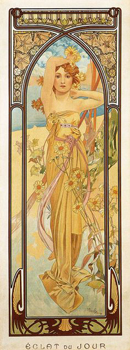Product Description
Egide Rombaux (attr.) Belgian Art Nouveau “Nymph and Iris” sculpture c.1900


EGIDE ROMBAUX attr. (1865-1942) Belgium
Nymph with Iris Blossoms c.1900
Finely hand carved ivory in the form of a full figure nymph with an iris blossom and buds, blue agate base with gilt bronze mounts
For more information see: Art Nouveau and Art Deco Lighting, Alastair Duncan (New York: Simon & Schuster, Publishers, 1978)
H: 9 1/2″
Price: 9,750
Egide Rombaux, born 1865 in Brussels, was the son of the sculptor Félix Rombaux and student of Charles van der Strappen and Joseph Lambeaux. Rombaux was one of the more eminent of the Belgian School at the turn of the century; he was awarded the prestigious Prix de Rome in 1891, and subsequently became a professor at the Institut superieur des Beaux-Arts in Anvers. Sculptor and medalist, he principally did ivory groups (such as his ‘Venusberg’, displayed at the 1897 chryselephantine Tervuren exposition, and his ‘Daughter of Satan’, now at the Musée Royale des Beaux-Arts in Brussels), portrait busts and statues. He also collaborated with silversmith Franz Hoosemans on a delightful range of candelabra and tablelamps.
Egide Rombaux (attr.) Belgian Art Nouveau “Nymph and Iris” sculpture c.1900
RUDOLF RIEGER Germany
WMF [WÜRTTEMBERGISCHE METALLWARENFABRIK] Geislingen, Germany
Dinanderie pair of vases c. 1930
Brass with a black patina and stylized silver inlay in a geometric motif
Marks: WMF castle mark
Illustrated: WMF Ikora Metall / Metalwork, Carlo Burschel and Heinz Scheiffele (Stuttgart, Germany: ARNOLDSCHE, 2006), p. 58, 156 and 185.
H: 3 1/4″ x Dia: 4″
Price: $1,950
Rudolf Rieger was in Paul Haustein’s master class and worked as self-employed goldsmith in Stuttgart. Between 1920 and 1930 he submitted designs for metal objects to WMF AG and from 1940 until 1941 he was the master instructor at the WMF art-metal division.
